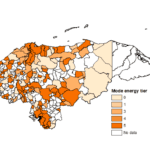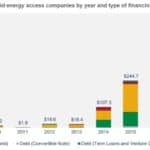Financing the Energy Access Revolution: Three Technologies That Are Driving Africa’s Momentum
Last year, the Tanzania-based social enterprise Simusolar raised $50,000 to finance its work selling solar powered systems to farmers and fishermen in rural areas traditionally excluded from mainstream energy provision.
In the context of sub-Saharan Africa’s multi-billion dollar energy access gap, the money raised was just a drop in the ocean. Yet as a symbol of the increasingly transformational role being played by technology in helping finance the drive towards universal energy access – in Africa and beyond – it was a particularly compelling one.
For a start, the money was raised on the Kiva microloan platform. Kiva is one of a growing number of online crowdfunding ventures that are directing money raised from the general public (in the form of small loans or investments) to individuals or small businesses in Africa and elsewhere that need capital to grow. The $50,000 raised by Kiva attracted $25,000 in match funding from Energy 4 Impact as part of our Crowd Power programme, supported by UK Aid.
Then there are the products that Simusolar offers its customers: These typically harness solar technology in some way to enable greater productivity – for example, solar-powered lanterns for night-time fishing, or solar water pumps to help farmers increase crop yields. Integral to all Simusolar’s solutions is built-in mobile technology that allows customers to easily pay for the products they buy in small increments over time, at a price they can afford.
Technology as a Game Changer in African Energy Access
Simusolar’s example neatly illustrates the extent to which technology has become central to the energy access story. At all key stages of the process – raising the initial capital, financing and paying for the equipment, and designing the final product itself – technology is the chief agent. And at the end of the process, subsistence farmers and fishermen are able to afford equipment that would otherwise be beyond their financial means – and to improve their livelihoods as a result. According to Simusolar, fishermen using its solar lanterns have reported a doubling of their income in the first year of use.
The new possibilities opened up by technology are a potential game-changer in Africa’s push towards greater energy access. According to the International Energy Agency, some 590 million Africans – around 50 percent of the population – are still without access to electricity, a figure that rises to 80 percent in rural areas. Unsurprisingly, closing this energy access gap has become an international priority. One of the United Nations’ Sustainable Development Goals aims for universal access to affordable energy by 2030, and a huge amount of good work to fulfil this ambition is now underway by actors across the institutional spectrum, from heavyweight international bodies like the World Bank to small local businesses. But as these efforts to improve the energy access situation in Africa continue, persistent challenges remain in securing the capital needed to close the gap.
On one level, the sums involved are vast: Recent International Energy Agency analysis put the cost of attaining universal energy access in sub-Saharan Africa by 2030 at $28 billion per year beyond currently planned levels of investment. But set against that backdrop are many complex questions about affordability and the flow of credit. How can households cover the costs of purchasing a solar home system when trying to live on a few dollars a day? How can farmers in rural Africa afford to buy relatively expensive equipment such as solar kits or access loans when they have no credit history? In the absence of effective, affordable local credit, how can small companies operating in the energy access space raise capital to supply customers with equipment at prices that are within their means?
The Mobile Revolution
We are involved in many projects aimed at answering these questions, and it’s clear that technology is playing an increasingly integral role in emerging solutions to the energy access challenge. A key development has been the growth of mobile phone penetration in sub-Saharan Africa, which stood at 44 percent of the population in 2017 and is forecast by industry body GSMA to reach 52 percent by 2025. This has enabled a number of very significant leaps forward, including opening up mobile money services to millions of people without prior access to even the most basic banking facilities.
While this access in itself has been transformative, lifting millions out of poverty, it has also opened up many new possibilities for energy access solutions. Mobile technology is an essential part of the business model of companies like Simusolar, enabling farmers and fishermen to make regular, affordable payments for equipment that would otherwise lie beyond their reach. Similarly, many solar home system providers use mobile-enabled pay-as-you-go (PAYGo) models to allow customers in off-grid locations to pay for equipment over time, in instalments they can afford due to the money they save from avoiding more costly, dirty sources of energy such as kerosene.
And of course, as these models become better established and understood, they create virtuous circles. On the customer side, making regular payments for their equipment lets them establish a credit history, enabling them to purchase further equipment – or even take steps towards greater participation in mainstream financial services.
In Uganda, for instance, the financial inclusion organisation FINCA has launched BrightLife, a social enterprise that sells products such as solar home systems and other productive use appliances to low-income Ugandans via PAYGo-enabled finance. Earlier this year BrightLife teamed up with FIBR (Financial Inclusion on Business Runways), a research project run by consultancy BFA and supported by the Mastercard Foundation that is exploring ways to connect financial services to low-income populations in Africa through digital innovation. FIBR is working with BrightLife and FINCA to develop new data analytics instruments to mine the credit data generated by BrightLife’s PAYGo customers and link them to better banking services. So energy access is serving as a stepping stone to the formal financial sector, all enabled by digital technology.
Meanwhile, on the business side, investors’ growing familiarity with mobile-enabled PAYGo business models is enabling companies operating in this space to access a wider pool of capital at more favourable rates – and in turn to expand their customer base. According to a report on the African mobile economy by GSMA, tech start-ups in Africa secured over $560 million in investment in 2017, a 53 percent increase on the previous year, with solar companies accounting for 21 percent of this.
And for both businesses and consumers, another important development is the growth in digital credit offerings. In Kenya alone there are an estimated 20 digital credit providers, offering households and entrepreneurs the opportunity to access loans through their mobile phones. While these loans are not restricted to energy-related expenditures, the fact that last-mile businesses and consumers have these new tech-enabled routes to credit will be of huge benefit to the ongoing development of energy access markets.
The Power of Crowdfunding
Beyond specific appliance-based solutions, digital technology is also helping introduce entirely new sources of capital to the energy access world.
Notably, crowdfunding campaigns similar to Simusolar’s are becoming increasingly popular among energy access companies operating in Africa and elsewhere. According to research undertaken as part of Energy 4 Impact’s Crowd Power programme, the amount of money raised through crowdfunding for energy access projects grew from $3.4 million in 2015 to $13.7 million last year. This still represents only a fraction of the total off-grid market, but crowdfunding undoubtedly has an important and growing role to play in closing the energy access finance gap.
The figures above are evidence of this; so too is the increasing size and ambition of crowdfunding campaigns. This year we saw the UK-based crowdfunding platform Lendahand team up with off-grid energy provider BBOXX on a multi-year crowdfunding campaign through which they hope to raise £2.5 million to finance BBOXX’s expansion into several new African countries.
Crowdfunding has even caught the eye of the development community as a serious vehicle for energy access finance. The UK’s secretary of state for international development, Penny Mordaunt, recently spoke of her interest in exploring how technology can connect UK citizens with opportunities to invest in projects overseas that have a positive social or environmental benefit, as well as a financial return. Crowdfunding very much fits within this narrative, and indeed the UK’s Department of International Development has agreed to co-fund money raised through Energise Africa, the wider crowdfunding platform (linked with Lendahand) used by BBOXX in the example cited above. Meanwhile, the Swedish development agency, Sida, recently agreeing to partially guarantee up to €10 million in investments made through the energy access crowdfunding platform Trine – one more sign of the growing role of crowdfunding in energy access financing.
The Blockchain Buzz
Less of a known quantity, but nonetheless generating significant buzz, is the application of blockchain and cryptocurrency technologies as a means of raising capital for energy access. It is probably worth sounding a note of caution that, as things stand, the hype around blockchain’s potential to revolutionise the global energy system substantially outweighs the number of concrete examples of this promise.
Nevertheless, some interesting applications are beginning to emerge that may suggest the shape of things to come. One is from the South Africa-based Sun Exchange, which has developed its own cryptocurrency, the SUNEX Token, that enables investors to buy shares in solar projects. Earlier this year the company announced a partnership with the mini-grid technology innovator Powerhive, under which Powerhive will use funds raised through sales of SUNEX to build solar-powered mini-grid projects in rural Kenya. Sun Exchange anticipates raising up to $23 million for Powerhive, enough for up to 150 projects, the company claims. It’s early days for this venture, but if Sun Exchange can prove its model out, it could represent an important new technology-enabled conduit for getting much needed investment into energy access projects.
In many ways, emerging technologies such as blockchain show that the story of digital innovation in energy access finance is just beginning. Technology is evolving at a dizzying pace, and the systems and models being deployed today may look very different from those coming just a few years down the line.
In an ideal world, commercial banks and other mainstream financial institutions would be responding to the pressing need for capital to close Africa’s energy access gap. But for many reasons, they are not doing so anywhere near quickly enough. Until they do, energy access is a space that will remain wide open for disruption. And though the future is hard to predict in such a fast-moving sector, one thing is certain: There are plenty of technology providers out there who would be only too happy to help fill the void.
Note: An earlier version of this article was first published on Energy4Impact. It was adapted and republished with permission
Ben Good is Chief Executive Officer at Energy 4 Impact.
Image courtesy of organization.
- Categories
- Energy, Social Enterprise, Technology



